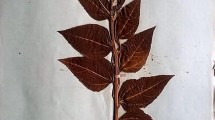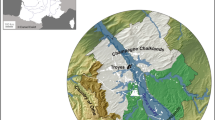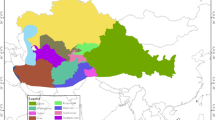Abstract
Pepino,Solanum muricatum, is an herbaceous subshrub that has long been grown in its native Andean South America. Pepino is usually cultivated for its edible fruits, but also has other economic uses. In spite of being a prominent crop in prehispanic times in the Andes, interest in pepino was cast into oblivion from some decades after the Spanish arrival to the present. Pepino etymology, prehispanic distribution, and postcolumbian dispersal are presented, with emphasis on outstanding historical aspects. Speculations on why the pepino has been neglected are also given. These include some features of pepino itself together with misconceptions. However, the pepino is today a species of increasing economic interest, and has a considerable potential for future exploitation.
Resumen
El pepino dulce (Solanum muricatum),es una planta herbácea que ha sido cultivada durante mucho tiempo en los Andes, su zona de origen. El pepino dulce normalmente se cultiva por sus frutos comestibles, aunque también tiene otros usos de importancia económica. A pesar de ser un cultivo importante en la zona andina durante la época precolombina, desde unas décadas después de la llegada de los españoles en adelante, el interés por el pepino dulce cayé en el olvido. En este artículo se presentan la etimología, distribución en la época precolombina y su difusión postcolombina, haciendo particular énfasis en los aspectos históricos más destacados. También se dan algunas razones que podrían haber tenido influencia para marginar al pepino dulce. Entre éstas se incluyen algunas carícterísticas propias del pepino dulce junto con falsas creencias. Sin embargo, en la actualidad, el pepino dulce es una planta con un interés económico creciente y con un potencial considerable para su explotación en el futuro.
Similar content being viewed by others
Literature Cited
Acosta, J. 1987. Historia natural y moral de las Indias. Vol. 1. Hispano-Americana de Publicaciones, Sevilla, Spain.
Aitón, W. 1789. Hortus kewensis, or a catalogue of the plants cultivated in the Royal Botanic Garden at Kew. Vol. 1. Royal Botanic Garden at Kew, London, U.K.
Alvarado, P. 1982. El cultivo del pepino dulce(Solanum muricatum, Ait.). Educational Document. Universidad de Chile, Santiago, Chile.
Anderson, G. J., and R. K. Jansen, n.d. Biosystematic and molecular systematic studies ofSolarium section Basarthrum and the origin and relationships of the pepino(S. muricatum). Annals of the Missouri Botanical Garden: in press.
—,and Y. Kim. 1996. The origin and relationships of the pepino,Solarium muricatum (Solanaceae): DNA restriction fragment evidence. Economic Botany 50:000–000.
Anonymous. 1892. The pepino,Solarium muricatum: recent publications. Garden and Forest 5:95-96.
Anonymous. 1903. Melon-pear. Gardeners' Chronicle 34:160.
Baccarini, P. 1908. II pera-meloneSolarium murcatum Ait. Una nuova pianta da frutto da coltivarsi in Italia. Bolletino della Reale Sovietá Toscana di Orticultura 33:327–331.
Bakker. 1995. Melón ‘Pepino’ (Advertisement). Catalogue Bakker España Primavera 1995:15.
Bitter, G. 1913. Zur Stammesgeschichte der Formen desSolarium muricatum. Feddes Repertorium 12: 441–444.
Bravo, A., and E. Arias. 1983. Cultivo del pepino dulce. Antecedentes agrnómicos y económicos. El Campesino 114(3): 15–34.
Brücher, H. 1989. Useful plants of neotropical origin and their wild relatives. Springer-Verlag, Berlin, Germany.
Bukasov, S. M. 1930. The cultivated plants of Mexico, Guatemala and Colombia. Translated by M. H. Byleveld from the original Russian text appearing as Bulletin of applied botany, genetics and plant breeding, Supplement 47.
Bürge, G. K. 1989. Fruit set in the pepino(Solarium muricatum, Ait.). Scientia Horticulturae 41:63–68.
Burton, W. G., J. G. Hawkes, and R. Salaman. 1985. The history and social influence of the potato. Cambridge University Press, Cambridge, U.K.
Carriel, R., A. Bravo, and A. Duimovic. 1982. Efectos de diferentes poblaciones de plantas sobre el rendimiento y características del fruto de pepino dulce(Solarium muricatum). Ciencia e Investigación Agraria 9:215–219.
Casella, D. 1955. Prosperano anche in Italia i fruttiferi subtropicali. Frutticoltura 1:23–37.
Chapot, H. 1955. Essais de culture de “poire-melon”(Solarium muricatum Ait.) au Maroc. Fruits 10: 123–124.
Cieza de León, P. 1984. La Crónica del Perú. Historia 16, Madrid, Spain.
Cobo, B. 1964a. Obras del P. Bernabé Cobo. Vol. 1. Atlas, Madrid, Spain.
-. 1964b. Obras del P. Bernabé Cobo. Vol. 2. Atlas, Madrid, Spain.
Cornejo, P., M. J. Esteban, and F. Nuez. 1990. Obtención de plántulas de pepino dulce a partir de semilla. Actas de Horticultura 4:312–316.
Cossio, F. 1986. II pepino o pera-melone, frutto esotico da sperimentare in orticultura. L’Informatore Agrario-Verona 42(29):49–51.
— 1988. II pepino(Solarium muricatum, Ait.): aspetti colturali, problemi e prospettive. Frutticoltura 50(10):67–76.
Dawes, S. N., and G. J. Pringle. 1983. Subtropical fruits from South and Central Americain G. Wratt and H. C. Smith, eds., Plant breeding in New Zealand. Butterworths, Wellington, New Zealand.
Dennis, D. J., G. K. Burge, and R. Lill. 1985. Pe pinos: cultural techniques. New Zealand Ministry of Agriculture and Fisheries. Aglink HPP 208, 2 p.
Ercan, N., and M. Akilli. 1995. Effects of various hormones on fruit set of pepino(Solarium muricatum Ait.). Abstracts of the 1st Int. Symp. on Solanaceae for fresh market (Málaga, Spain, 28–31 March 1995):94
Esquivel, M., and K. Hammer. 1991. The cultivated species of the family Solanaceae in Cuba. Pages 357–364in J. G. Hawkes, R. N. Lester, M. Nee, and N. Estrada, eds., Solanaceae III: Taxonomy, chemistry, evolution. Royal Botanic Gardens Kew and Linnean Society of London, London, U.K.
Estrella, E. 1990. El pan de América: etnobotánica de los alimentos aborígenes en el Ecuador. AbyaYala, Quito, Ecuador.
Everett, T. H. 1982. The New York Botanical Garden illustrated encyclopedia of horticulture. Vol. 9. Garland Publishing Inc., New York, NY.
Fernández de Oviedo, G. 1992. Historia general y natural de las Indias. Vol. 5. Atlas, Madrid, Spain.
Font-Quer, P. 1979. Diccionario de botánica. Labor, Barcelona, Spain.
Fouqué, A. 1973. Espéces fruitiéres d’Amérique tropicale: Famille des Solanacées. Fruits 28:41–49.
Goubran, F. H. 1985. Growing and marketing of pepinos. Department of Agriculture, Victoria Agnote Agdex 268/11, 3 pp.
Grigg, F. D. W., P. R. Smith, M. A. Stenersen, and B. G. Murray. 1988. Variable pollen fertility and abnormal chromosome behaviour in the pepino(Solarium muricatum Ait., Solanaceae). Scientia Horticulturae 35:259–268.
Haworth, D. 1988. Pepinos head for Japan. Growing Today (8/9):8–9.
Heiser, C. B. 1964. Origin and variability of the pepino(Solarium muricatum): A preliminary report. Baileya 12:151–158.
— 1969. Nightshades: the paradoxical plants. W. H. Freesman, San Francisco, CA.
— 1985. Of plants and people. University of Oklahoma Press, Norman, OK.
Hermann, M. 1987. Fruit formation inSolarium muricatum as affected by nitrogen supply and temperatures. Poster on the 14th International Botanical Congress. Berlin-West, Germany, 24 July—1 Aug., 3 pp.
Jimánez de la Espada, M. 1965. Relaciones Geogr'aficas de Indias-Perú. Vol. 2. Atlas, Madrid, Spain.
Joo, M. K., C. S. Kim, and S. T. Yoon. 1990. The effect of transplanting date, fruit set and thinning method on the growth and yield of pepino(Solanum muricatum Ait.) Journal of the Korean Society for Horticultural Science 31:121–124 (Abstract).
Kays, S. J., and J. C. Silva. 1995. Common name of commercially cultivated vegetables of the World in 15 languages. Economic Botany 49:115–152.
Larco, R. 1984. Perú. Juventud, Barcelona, Spain.
Latcham, R. E. 1936. La agricultura precolombiana en Chile y los países vecinos. Ediciones de la Universidad de Chile, Santiago, Chile.
Lizana, L. A., and B. Levano. 1977. Caracterización y comportamiento de post-cosecha del pepino dulce,Solarium muricatum, Ait. Proceedings of the Tropical Region, American Society for Horticultural Science 21:11–15.
Luo, W. F. 1994. New sort of vegetableSolarium muricatum and techniques for its cultivation. Chinese Vegetables 1:53–54 (Abstract).
MAPA. 1993. Relación de especies americanas introducidas en España desde mediados del siglo XVIII hasta principios del siglo XIX. Ministerio de Agricultura, Pesca y Alimentación, Madrid, Spain.
Martínez, J. A., J. J. Ruiz, J. Costa, and F. Nuez. 1995. Producción temprana de pepino dulce en cultivo bajo invernadero. Agrícola Vergel 14:142–145.
Maynard, D. N. 1989. Specialty vegetable production in Florida, USA. Acta Horticulturae 242:203–215.
McBryde, F. W. 1945. Cultural and historical geography of Southwest Guatemala. Smithsonian Institution. Institute of Social Anthropology Publication No. 4, Washington, DC.
Mione, T., and G. J. Anderson. 1992. Pollen-ovule ratios and breeding system evolution inSolarium sectionBasarthrum (Solanaceae). American Journal of Botany 79:279–287.
Morley-Bunker, M. J. S. 1983. A new commercial crop, the pepino(Solarium muricatum, Ait.) and suggestions for further development. Annual Report of the Royal New Zealand Institute of Horticulture 11:8–19.
Murray, B. G., K. R. W. Hammett, andF. D. W. Grigg. 1992. Seed set and breeding system in the pepinoSolarium muricatum, Ait., Solanaceae. Scientia Horticulturae 49:83–92.
Nanetti, A. 1912. Sulle probabili cause della partenocarpia delSolarium muricatum Ait. Nuovo Giornale Botánico Italiano 19:91–111.
National Research Council. 1989. Lost crops of the Incas. Little-known plants of the Andes with promise for worldwide cultivation. National Academy Press, Washington, DC.
Nuez, F., R. Morales, J. J. Ruiz, P. Fernández de Cordova, E. Valdivieso, and F. I. González. 1993. Recolección de especies hortícolas en Ecuador. FAO/IPGRI Plant Genetic Resources Newsletter 96:29–33.
-,and J. J. Ruiz. n.d. El pepino dulce y su cultive FAO, Rome, Italy (in press).
Palma, R. 1968. Tradiciones peruanas completas. Aguilar, Madrid, Spain.
Patiño, V. M. 1963. Plantas cultivadas y animales domésticos en América equinoccial. Vol. 1. Imprenta Departamental, Cali, Colombia.
Péron, J. Y., E. Demaure, and C. Hamnetel. 1989. Les possibilités d’introduction et de développement de solanacées et de cucurbitacées d’origine tropicale en France. Acta Horticulturae 242:179–186.
Pizarro, P. 1978. Relación del descubrimiento y conquista de los reinos del Perú. Pontificia Universidad Católica del Perú, Lima, Peru.
Pluda, D., H. D. Rabinovitch, and U. Kafkafl. 1993. Pepino dulce(Solarium muricatum Ait.) quality characteristics respond to nitrogen nutrition and salinity. Journal of the American Society for Horticultural Science 118:86–91.
Redgwell, R. J., and N. A. Turner. 1986. Pepino(Solarium muricatum): Chemical composition of ripe fruit. Journal of the Science of Food and Agriculture 37:1217–1222.
Rick, C. M. 1978. The tomato. Scientific American 239:66–76.
Ruiz, H. 1952. Relación histórica del viage, que hizo a los Reinos del Perú y Chile el botánico D. Hipólito Ruiz en el año de 1777 hasta el de 1788, en cuya época regresó a Madrid. Vol. 1. Real Academia de Ciencias Exactas, Físicas y Naturales, Madrid, Spain.
—,and J. Pavón. 1957. Flora peruviana et chilensis. Vol. 2. Instituto de Botánica Antonio Josá de Cavanilles, Madrid, Spain.
Ruiz, J. J., and F. Nuez. 1991. Primeras observaciones sobre la adaptación de pera-melón(Solatium muricatum Ait.) en España. Actas de Horticultura 8:319–323.
— 1993. Efectos de la polinización y competencia entre frutos sobre el cuajado del pepino dulce. Actas de Horticultura 10:1032–1037.
— 1994. Respuesta de híbridos y clones de pepino dulce al estrés salino y fertilización potásica 1. Caracteres productivos y vegetativos. Actas de Horticultura 12:251–258.
—,M. Amurrio, A. de Ron, andM. Fueyo. 1992. Adaptation of the pepino(Solatium muricatum Ait.) in Spain. Acta Horticulturae 318: 213–216.
-,J. Prohens,and F. Nuez. n.d. Efecto de la temperatura sobre el cuajado y maduración de los frutos de pepino dulce. Actas de Horticultura (in press).
Sánchez-Monge, E. 1991. Flora Agrícola. Vol. 1. Ministerio de Agricultura, Pesca y Alimentación, Madrid, Spain.
Sánchez-Vega, I. 1992. Frutales andinos. Pages 179–183in J. E. Hernández-Bermejo and J. León, eds., Cultivos marginados: otra perspectiva de 1492. FAO, Rome, Italy.
Schultes, R. E., and R. Romero-Castañeda. 1962. Edible fruits ofSolanum in Colombia. Harvard University Botanical Museum Leaflets 19:235–286.
Seidel, H. 1974. Efahrungen mit dem Anbau vonSolanum muricatum in Südspanien. Der Tropenlandwirt, Zeitschrift für die Landwirtschaft in den Tropen und Subtropen 75(4):24–30.
Siegenthaler, I. E. 1973. Useful plants of Ethiopia. Experiment Station Bulletin Nº. 14, Vol. I. Imperial Ethiopian College of Agricultural and Mechanical Arts, Jima Experiment Station, USAID Contract Publication.
Sweet, C. 1986. Pepino: can it grow here?. California Grower 10(7): 19–34.
Tioutine, M. G. 1937. Le melon-poire,Solanum muricatum Ait. Revue Horticole 109:611–615.
Towle, M. A. 1961. The ethnobotany of Pre-Columbian Peru. Aldine Publidhing Co., Chicago, IL.
Valcárcel, J. V. 1995. Respuesta del pepino dulce(Solanum muricatum Ait.) a la aplicacián de hidroxi-MCPA y ethephon en ciclo de otoño-invierno. Unpublished Ing. Téc. Agr. Thesis, Universidad Politécnica de Valencia, Valencia, Spain.
Van der Slikke,C.M. 1951. Mogelijkheden Voor de Peermeloen(Solanum muricatum, Ait.). Mededelingen Directeur van de Tuinbow 14:157–161.
Vargas, C. 1962. Phytomorphic representations of the ancient peruans. Economic Botany 16:106–115.
Vázquezde Espinosa,A. 1969. Compendio y descripción de las Indias Occientales. Atlas, Madrid, Spain.
Vincenzoni, A. 1988. Application of soilless culture for producing pepinos(Solanum muricatum). Proceedings of the International Society on Soilless Culture, p. 465–468.
Welles, G. W. H. 1992. Experiences with growing and consumer appreciation of pepino fruits(Solanum muricatum) in the Netherlands. Acta Horticulturae 318:211–212.
Wickson, E. J. 1914. The California fruits and how to grow them. Pacific Rural Press, San Francisco, CA.
Zamora, A. 1980. Historia de la provincia de San Antonino del Nuevo Reino de Granada. Instituto Colombiano de Cultura Hispánica, Bogotá, Colombia.
Author information
Authors and Affiliations
Rights and permissions
About this article
Cite this article
Prohens, J., Ruiz, J.J. & Nuez, F. The pepino(Solanum muricatum, Solanaceae): A “New” crop with a history. Econ Bot 50, 355–368 (1996). https://doi.org/10.1007/BF02866518
Received:
Accepted:
Issue Date:
DOI: https://doi.org/10.1007/BF02866518




